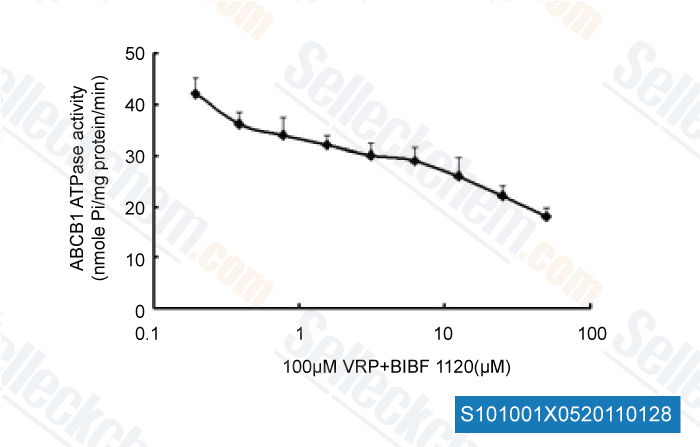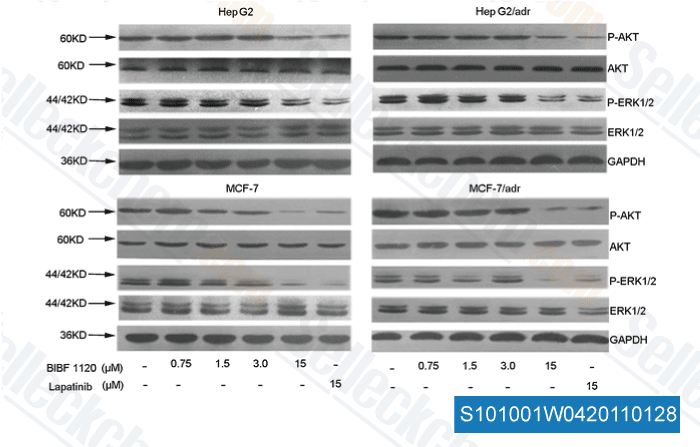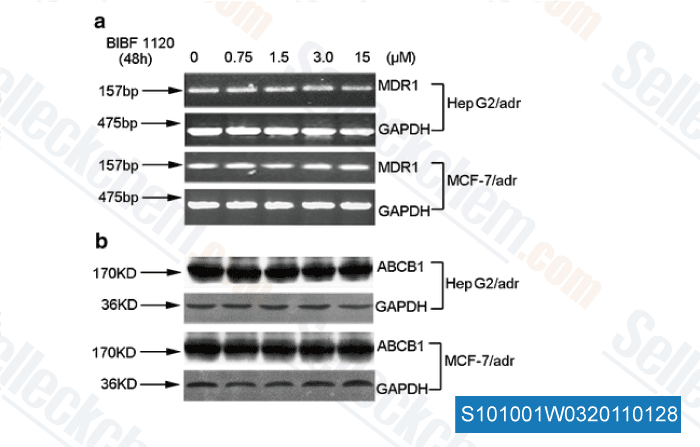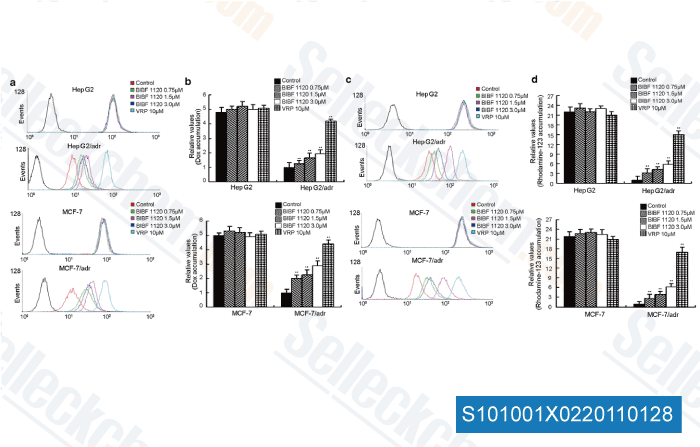|
Toll Free: (877) 796-6397 -- USA and Canada only -- |
Fax: +1-832-582-8590 Orders: +1-832-582-8158 |
Tech Support: +1-832-582-8158 Ext:3 Please provide your Order Number in the email. |
Technical Data
| Formula | C31H33N5O4 |
|||
| Molecular Weight | 539.62 | CAS No. | 656247-17-5 | |
| Solubility (25°C)* | In vitro | DMSO | 4 mg/mL (7.41 mM) | |
| Ethanol | 2 mg/mL (3.7 mM) | |||
| Water | Insoluble | |||
|
* <1 mg/ml means slightly soluble or insoluble. * Please note that Selleck tests the solubility of all compounds in-house, and the actual solubility may differ slightly from published values. This is normal and is due to slight batch-to-batch variations. * Room temperature shipping (Stability testing shows this product can be shipped without any cooling measures.) |
||||
Preparing Stock Solutions
Biological Activity
| Description | Nintedanib is a potent triple angiokinase inhibitor for VEGFR1/2/3, FGFR1/2/3 and PDGFRα/β with IC50 of 34 nM/13 nM/13 nM, 69 nM/37 nM/108 nM and 59 nM/65 nM in cell-free assays. Phase 3. | |||||||||||
|---|---|---|---|---|---|---|---|---|---|---|---|---|
| Targets |
|
|||||||||||
| In vitro | BIBF1120 inhibits PDGFR kinase activity of PDGFR alpha and PDGFR beta types with IC50 values of 59 nM and 65 nM, respectively. In addition, BIBF1120 suppresses the FGFR subtypes with IC50 of 60 nM, 37 nM and 108 nM for FGFR1, FGFR2, and FGFR3, respectively. BIBF1120 binds to the ATP-binding site in the cleft between the amino and carboxy terminal lobes of the kinase domain. The indolinone scaffold forms two hydrogen bonds with the backbone nitrogen of Cys919 and the backbone carbonyl oxygen of Glu917 in the hinge region. BIBF 1120 inhibits proliferation of PDGF-BB stimulated BRPs with EC50 of 79 nM in cell assays. BIBF1120 at concentrations as low as 100 nM blocks activation of MAPK after stimulation with 5% serum plus PDGF-BB. In cultures of human vascular smooth muscle cells (HUASMC), BIBF1120 prevents PDGF-BB stimulated proliferation with an EC50 of 69 nM. [1] |
|||||||||||
| In vivo | In all tumor models tested thus far, including human tumor xenografts growing in nude mice and a syngeneic rat tumor model, BIBF1120 is highly active at well-tolerated doses (25-100 mg/kg daily p.o.). This is evident in the magnetic resonance imaging of tumor perfusion after 3 days, reducing vessel density and vessel integrity after 5 days, and profound growth inhibition. [1] |
Protocol (from reference)
| Kinase Assay: |
|
|---|---|
| Cell Assay: |
|
| Animal Study: |
|
References
Customer Product Validation

-
Data from [Cell Oncol , 2011, 34, 33–44]

-
Data from [Cell Oncol , 2011, 34, 33–44]

-
Data from [Cell Oncol , 2011, 34, 33–44]

-
Data from [Cell Oncol , 2011, 34, 33–44]
Selleck's Nintedanib has been cited by 146 publications
| Impact of Nintedanib and Anti-Angiogenic Agents on Uveal Melanoma Cell Behavior [ Invest Ophthalmol Vis Sci, 2024, 65(2):30] | PubMed: 38381412 |
| Crosstalk with lung fibroblasts shapes the growth and therapeutic response of mesothelioma cells [ Cell Death Dis, 2023, 10.1038/s41419-023-06240-x] | PubMed: 37938546 |
| Identification of Paired-related Homeobox Protein 1 as a key mesenchymal transcription factor in pulmonary fibrosis [ Elife, 2023, 12e79840] | PubMed: 37261432 |
| Identification of Paired-related Homeobox Protein 1 as a key mesenchymal transcription factor in pulmonary fibrosis [ Elife, 2023, 12e79840] | PubMed: 37261432 |
| Differences in Treatment Response in Bronchial Epithelial Cells from Idiopathic Pulmonary Fibrosis (IPF) Patients: A First Step towards Personalized Medicine [ Antioxidants (Basel), 2023, 12(2)443] | PubMed: 36830000 |
| Differences in Treatment Response in Bronchial Epithelial Cells from Idiopathic Pulmonary Fibrosis -IPF) Patients: A First Step towards Personalized Medicine [ Antioxidants -Basel), 2023, 12(2)443] | PubMed: 36830000 |
| Lenvatinib enhances antitumor immunity by promoting the infiltration of TCF1+ CD8+ T cells in HCC via blocking VEGFR2 [ Cancer Sci, 2023, 114(4):1284-1296] | PubMed: 36609997 |
| Lenvatinib enhances antitumor immunity by promoting the infiltration of TCF1+ CD8+ T cells in HCC via blocking VEGFR2 [ Cancer Sci, 2023, 114(4):1284-1296] | PubMed: 36609997 |
| Combination therapy with anti-programmed cell death 1 antibody plus angiokinase inhibitor exerts synergistic antitumor effect against malignant mesothelioma via tumor microenvironment modulation [ Lung Cancer, 2023, 180:107219] | PubMed: 37146474 |
| Antineoplastic efficacy profiles of avapritinib and nintedanib in KIT D816V+ systemic mastocytosis: a preclinical study [ Am J Cancer Res, 2023, 13(2):355-378] | PubMed: 36895976 |
RETURN POLICY
Selleck Chemical’s Unconditional Return Policy ensures a smooth online shopping experience for our customers. If you are in any way unsatisfied with your purchase, you may return any item(s) within 7 days of receiving it. In the event of product quality issues, either protocol related or product related problems, you may return any item(s) within 365 days from the original purchase date. Please follow the instructions below when returning products.
SHIPPING AND STORAGE
Selleck products are transported at room temperature. If you receive the product at room temperature, please rest assured, the Selleck Quality Inspection Department has conducted experiments to verify that the normal temperature placement of one month will not affect the biological activity of powder products. After collecting, please store the product according to the requirements described in the datasheet. Most Selleck products are stable under the recommended conditions.
NOT FOR HUMAN, VETERINARY DIAGNOSTIC OR THERAPEUTIC USE.
